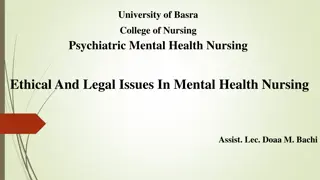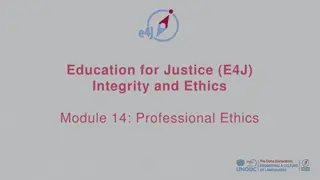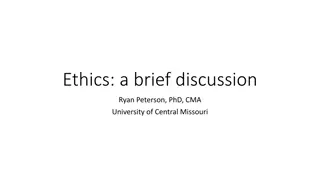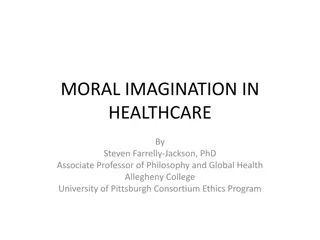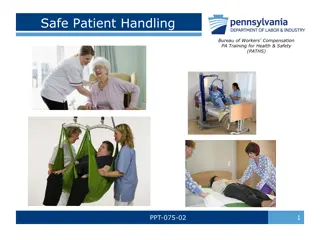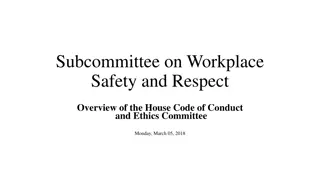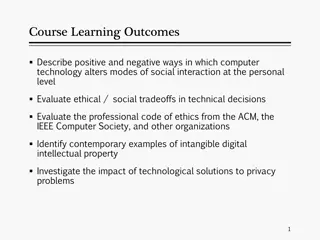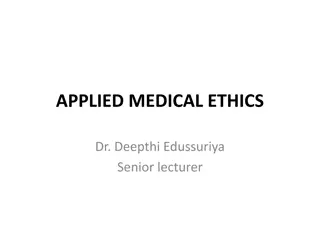Ethics and Patient Rights in Healthcare: A Professional Training Module
This module on ethics and patient rights in healthcare training covers essential topics such as defining ethics, ethical decision-making processes, building ethical relationships with patients, understanding the Patient's Bill of Rights, and identifying ethical principles related to compliance with laws and regulations. It also explores the various sources of ethical standards in healthcare. The content is designed to enhance the professionalism and competence of oncology patient navigators.
Download Presentation

Please find below an Image/Link to download the presentation.
The content on the website is provided AS IS for your information and personal use only. It may not be sold, licensed, or shared on other websites without obtaining consent from the author. Download presentation by click this link. If you encounter any issues during the download, it is possible that the publisher has removed the file from their server.
E N D
Presentation Transcript
Lesson 2: Ethics and Patient Rights Module 6: Professionalism Oncology Patient Navigator Training: The Fundamentals
Acknowledgments This work was supported by Cooperative Agreement #1U38DP004972- 02 from the Centers for Disease Control and Prevention. Its contents are solely the responsibility of the authors and do not necessarily represent the official views of the Centers for Disease Control and Prevention. Portions of this lesson have been adapted with permission from: The Patient Navigator Training Collaborative of the Colorado School of Public Health We would like to thank: The GW Clinical Learning and Simulation Skills (CLASS) Center for providing space to film video simulations for this lesson Patient navigator actors in the simulation video: Thelma D. Jones
Competencies This lesson covers the following Core Competencies for Patient Navigators: 5.4 Demonstrate responsiveness to patient needs within scope of practice and professional boundaries 5.5 Know and support patient rights 5.7 Demonstrate a commitment to ethical principles pertaining to confidentiality, informed consent, business practices and compliance with relevant laws, policies and regulations (e.g., HIPAA, agency abuse reporting rules, Duty to Warn, safety contracting)
Learning Objectives After completing this lesson, you will be able to: Define ethical standards as it relates to the health care system Describe a process for ethical decision-making Discuss how to build ethical relationships with patients Describe the Patient's Bill of Rights Identify opportunities to support patient rights Identify ethical principles related to compliance with laws, policies and regulations
What is Ethics? Ethics does not equal: Emotions Religion Law Culture Science Source: Santa Clara University. n.d.
Definition of Ethics A process of navigating and negotiating values in order to act with integrity as an individual, organization or society. Source: PNTC
Five Sources of Ethical Standards Utilitarian Approach Rights Approach Fairness or Justice Approach Common Good Approach Virtue Approach Source: Santa Clara University. n.d.
Navigating an Ethical Dilemma Click here to watch the video
Framework for Ethical Decision-Making Step 1 Recognize an ethical issue Step 2 Get the facts Step 3 Evaluate alternative actions Step 4 Make a decision and test it Step 5 Act and reflect on the outcome Source: Santa Clara University. n.d.
Step One: Recognize an Ethical Issue Could this decision or situation be damaging to someone or to some group? Does this decision involve a choice between a good and bad alternative, or perhaps between two goods or between two bads ? Is this issue about more than what is legal or what is most efficient? If so, how? Source: Santa Clara University. n.d.
Step Two: Get the Facts What are the relevant facts of the case? What facts are not known? Can I learn more about the situation? Do I know enough to make a decision? The patient doesn t meet the standards Other resources may be available for the patient What individuals and groups have an important stake in the outcome? Are some concerns more important? Why? The patient would like financial assistance Source: Santa Clara University. n.d. What are the options for acting? Have all the relevant persons and groups been consulted? Have I identified creative options?
Step Three: Evaluate Alternative Actions Which option will produce the most good and do the least harm? (Utilitarian Approach) Which option treats people equally or proportionately? (Justice Approach) Which option leads me to act as the sort of person I want to be? (Virtue Approach) Which option best respects the rights of all who have a stake? (Rights Approach) Which option best serves the community as a whole, not just some members? (Common Good Approach) Source: Santa Clara University. n.d.
Step Four: Make a Decision and Test It Considering all these approaches, which option best addresses the situation? If I told someone I respect - or told a television audience - which option I have chosen, what would they say? Source: Santa Clara University. n.d.
Step Five: Act and Reflect on the Outcome How can my decision be implemented with the greatest care and attention to the concerns of all stakeholders? How did my decision turn out and what have I learned from this specific situation? Source: Santa Clara University. n.d.
Other Skills in Action Evaluated appropriateness of resources for the patient Stewarded resources Used strategies for communicating with empathy Used active listening methods
Ethics in the Healthcare System Respect the rights and dignity of patients Respect clinician judgments Provide optimal clinical care to each patient Avoid imposing nonclinical risks and burdens on patients Address health inequalities Conduct continuous learning activities that improve the quality of clinical care and health care systems Contribute to the common purpose of improving the quality and value of clinical care and health care systems Source: Wells et al. 2008.
Building Strong Ethical Relationships with Patients Going above the call of duty is not always a good idea Be clear about your role upfront Keep patient information private Be patient with patients Communicate like a professional Active, reflective listening Focusing on the patient Providing accurate information Source: PNTC
Ethical Principles & Compliance with Laws, Policies & Regulations Patient Bill of Rights HIPAA Patient Informed Consent Responsibilities
Checkpoint Which of the following is a patient responsibility according to the Patient Bill of Rights? a) Request personal healthcare records b) Choose healthcare provider c) Disclose information about their health d) Complain about their healthcare
Patient Rights & Responsibilities Patient Rights Patient Responsibilities See their healthcare records and get accurate and easy to understand information Patients are responsible for their own health Choose their healthcare providers and plans Patients must disclose information Access emergency services Patients must be financially and administratively responsible Be part of treatment decisions Patients must be respectful of others Be treated with respect and without discrimination Have their health information kept private Complain about their healthcare Source: Consumer Bill of Rights and Responsibilities. 1998.
Informed Consent A patient must understand: The purpose of the treatment/clinical trial What will happen during the treatment/clinical trial Benefits and risks of participating in treatment/the clinical trial Patient s rights Who to contact if the patient has questions or feels they have been mistreated Source: PNTC
Opportunities to Support Patient Rights Support patient understanding of condition and treatment Support patient decision-making Support access to second opinion Source: PNTC
Health Insurance Portability and Accountability Act (HIPAA) Created in 1996 to protect patient privacy. HIPAA Privacy Rules: Set limits on who has the right to use a patient's written, spoken or electronic health information Describes how healthcare organizations and insurance providers must protect health information including: How to handle protected health information How to share information What type of information can be shared With whom they can share information Source: Department of Health and Human Services Health Information Privacy. 2015.
Who is Subject to HIPAA Healthcare Providers Doctors Clinics Hospitals Psychologists Chiropractors Nursing Homes Pharmacies Dentists Health Insurers Health insurance companies HMOs Company Health Plans Government Programs (Medicare and Medicaid) Source: Department of Health and Human Services Health Information Privacy. 2015.
HIPAA & Protected Health Information (PHI) Name Address (all geographic subdivisions smaller than state, including street address, city, county, ZIP code) Telephone numbers FAX number E-mail address Web URL (web address) Contact information Electronic contact information Internet Protocol (IP) address numbers Dates related to a patient or their care Birth or death date Admission or discharge date Identifying numbers Social Security Number Medical record number Health plan beneficiary number Account number Certificate/license number Device identifiers or serial numbers Device or vehicle numbers Any vehicle or other device serial number Pictures, fingerprints, voice recordings (digital or analog) Source: Department of Health and Human Services Health Information Privacy. 2015. Any other characteristic that could uniquely identify the individual
Identifiers Identifiers connect a person to their medical information. Name Date of Birth Treatment Date Social Security Number De-identified information has identifiers removed and is used by Researchers Medical Students Source: Department of Health and Human Services Health Information Privacy. 2015.
Guidelines for Protecting Health Information 1. Use only the minimum information needed to do your job Share only amount needed by other service providers or family 2. If in doubt about giving information, get patient authorization. Signed form from patient 3. Keep PHI secure Ensure only those who need to know, see or hear patient information are able to Source: PNTC
Examples of HIPAA Breaches A health-system accidentally posted the thousands of its patients medical records online. A pharmacy s used computer was resold while still containing customer s prescription records. The data included names, addresses, social security numbers and medications purchased. A county health board member, who was also a banker, accessed health records and identified cancer patients. The banker placed notices on their mortgages. Source: UC Davis Medical Center. 2015.
Is this a HIPAA Breach? Taking home your notebook with all your patient information on the weekend? Telling your partner about a patient? Checking the lab results of your next door neighbor, who you are not navigating? Telling the social worker that you believe your patient is suicidal?
Legal Obligations Abuse reporting rules Duty to Warn Safety Contracting
Duty to Warn Pose a danger to themselves or others Source: National Conference of State Legislatures. 2013.
Reporting Abuse or Neglect Human services providers Health care providers Child care providers Education providers Law enforcement Talk with you supervisor about the organization s process for reporting abuse Become familiar with the local and state laws and reporting agencies Source: New York State Office of Children and Family Services. n.d.
Safety Contracting Practice between therapist and patient that established a patient s vow to not harm themselves on purpose or accidentally. It is not the patient navigator s role to assess a patient s intentions to harm themselves. It is your responsibility to seek doctor or supervisor immediately. Source: Garvey et al. 2009.
Conclusion In this lesson you learned to: Define ethical standards as it relates to the health care system Describe a process for ethical decision-making Discuss how to build ethical relationships with patients Describe the Patient's Bill of Rights Identify opportunities to support patient rights Identify ethical principles related to compliance with laws, policies and regulations
References Garvey, K. A., Penn, J. V., Campbell, A. L., Esposito Symthers, C., & Spirito, A. (2009). Contracting for safety with patients: Clinical practice and forensic implications. Journal of the American Academy of Psychiatry and the Law Online, 37(3):363 370. Retrieved April 15, 2021, from https://pubmed.ncbi.nlm.nih.gov/19767501/. National Conference of State Legislatures. (2013). Mental health professionals duty to warn. http://www.ncsl.org/research/health/mental health professionals duty to warn.aspx. New York State Office of Children and Family Services. (n.d.). Reporting abuse or neglect. http://ocfs.ny.gov/main/assets/CPS_Reporting_NYC_OCFS.pdf. Patient Navigator Training Collaborative. (n.d.). http://patientnavigatortraining.org/. Santa Clara University. (2009). Ethical decision making: A framework for ethical decision making. http://www.scu.edu/ethics/practicing/decision/. U.S. Department of Health and Human Services. (1998). President s advisory commission on consumer protection and quality in the health care industry, appendix A: Consumer bill of rights and responsibilities. http://archive.ahrq.gov/hcqual/final/append_a.html. UC Davis Medical Center. (2015). Compliance program. http://www.ucdmc.ucdavis.edu/compliance/guidance/privacy/example.html. Wells, K. J., Battaglia, T. A., Dudley, D.J., Garcia, R., Greene, A., Calhoun, E., Mandelblatt, J. S., Paskett, E. D., Raich, P. C., & Patient Research Program.(2008). Patient navigation: State of the art or is it science? Cancer,113(8):1999 2010. doi: 10.1002/cncr.23815.
Thank you! Follow us on Twitter: @GWCancer www.gwcancercenter.org Sign-up for the GW Cancer Center s Patient Navigation and Survivorship E-Newsletter: bit.ly/PNSurvEnews Sign-up for the GW Cancer Center s Cancer Control Technical Assistance E-Newsletter: bit.ly/TAPenews







